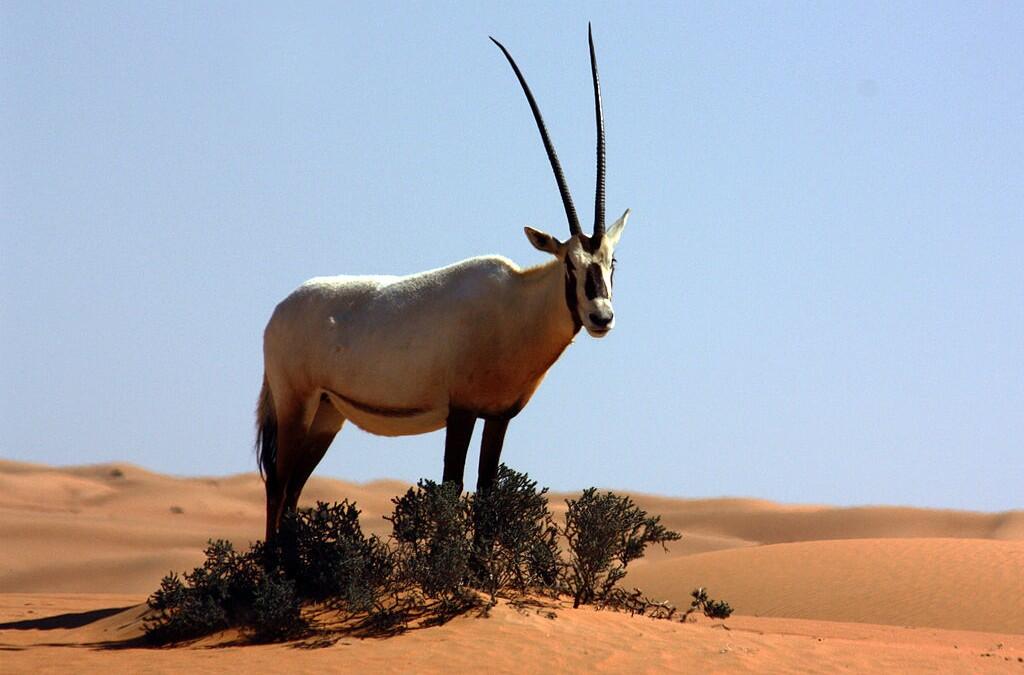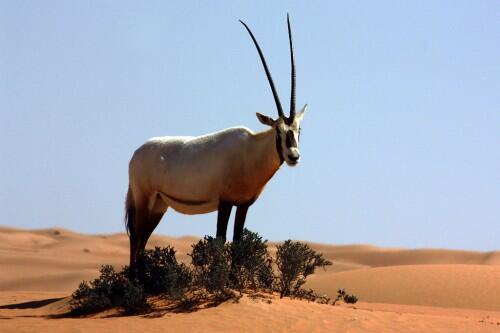“Biosphere Expeditions” is calling for volunteers interested in conserving the Arabian oryx and other desert species. If you were interested in visiting the fascinating and iconic sandy desert landscape of the Arabian Peninsula, that conservation project will take you to it.
The Biosphere Expeditions website mentioned that “Working alongside scientists from the Dubai Desert Conservation Reserve, you will be part of a small international team, monitoring Arabian oryx, Gordon’s wildcat, sand fox, mountain and sand gazelles, as well as other flagship species of the desert”.
It added that “From a comfortable oasis field camp you will venture out in the expedition 4WDs and on foot to study antelope behaviour and social structures, camera- and live-trap Gordon’s wildcat and sand fox, and monitor them by radio and GPS telemetry. All this to ensure the survival of important flagship desert species in their beleaguered world”.
In order to get a better idea of what it would be like volunteering in that adventure, the website posted the following testimonial: “This was my first expedition and I was not sure what to expect. I was wanting the adventure of a lifetime and I certainly got that and more. A real feel for ancient times, met real people, climbed dunes. The desert and indeed the country is spectacular, the sand driving is great fun, the camp is great. To see the light and mist appear with the sun shining on the mountains – it’s out of this world. I got to be Indiana Jones for a week. Thanks to all.”
Let’s get to know the Arabian Oryx a bit more… and we will be publishing reports about the other animals soon…
The Arabian Oryx:
The Arabian oryx is a medium-sized antelope with a distinct shoulder bump, long, straight horns, and a tufted tail. It is a bovid, and the smallest member of the Oryx genus, native to desert and steppe areas of the Arabian Peninsula. The Arabian oryx was extinct in the wild by the early 1970s, but was saved in zoos and private preserves, and was reintroduced into the wild starting in 1980.
Conservation of this National Animal of the UAE
The Phoenix Zoo and the Fauna and Flora Preservation Society of London (now Fauna and Flora International), with financial help from the World Wildlife Fund, are credited with saving the Arabian oryx from extinction. In 1962, these groups started the first captive-breeding herd in any zoo, at the Phoenix Zoo, sometimes referred to as “Operation Oryx”. Starting with 9 animals, the Phoenix Zoo has had over 240 successful births. From Phoenix, oryx were sent to other zoos and parks to start new herds.
Arabian oryx were hunted to extinction in the wild by 1972. By 1980, the number of Arabian oryx in captivity had increased to the point that reintroduction to the wild was started. The first release, to Oman, was attempted with oryx from the San Diego Wild Animal Park.Although numbers in Oman have declined, there are now wild populations in Saudi Arabia and Israel, as well. One of the largest populations is found in Mahazat as-Sayd Protected Area, a large, fenced reserve in Saudi Arabia, covering more than 2000 km2.
Arabian oryx (Oryx leucoryx) in the Dubai Desert Conservation Area, UAE. Sharp Photography
In June 2011, the Arabian oryx was relisted as vulnerable by the IUCN Red List. The IUCN estimated more than 1,000 Arabian oryx in the wild, with 6,000–7,000 held in captivity worldwide in zoos, preserves, and private collections. Some of these are in large, fenced enclosures (free-roaming), including those in Syria (Al Talila), Bahrain, Qatar, and the UAE.This is the first time the IUCN has reclassified a species as vulnerable after it had been listed as extinct in the wild.
On June 28, 2007, Oman’s Arabian Oryx Sanctuary was the first site ever to be removed from the UNESCO World Heritage List. UNESCO’s reason for this was the Omani government’s decision to open 90% of the site to oil prospecting. The Arabian oryx population on the site has been reduced from 450 in 1996 to only 65 in 2007. Now, fewer than four breeding pairs are left on the site.
Symbol of Authenticity
The Arabian oryx, which represents an icon of authenticity and heritage for Qatar, has been chosen as a symbol by many government and private institutions, and authorities have protected the unique animal from extinction by establishing natural reserves.
Qatar maintains care for the Arabian oryx through attention to the natural reserves, as a part of a policy to preserve the wildlife, providing nutrition according to scientific basis, as well as conducting research. They have install pamphlets addressed to the reserve administration on care for newborns and their mothers.
Qatari Director of the Natural Reserves Bureau Talal Bin Jabr Al-Nuaimi told “KUNA” that the idea of maintaining the Arabian oryx started with Sheikh Jassem bin Hamad Al-Thani in 1964, after trekking into empty deserts coming across the beautiful animal. Later, two Qatari groups followed suit with similar interest to this animal, until the number of oryx raised in farms totaled 120 in 1978.
Al-Nuaimi added that in 1979, the first reserve for the Arabian oryx was established in Al-Shahhaniya area, with the number not exceeding 17, but they multiplied later on.
In the early 90s, Qatar established government agencies tasked with oryx breeding and care, set up Al-Asharej Reserve in the north and Al-Masehabya Reserve southwest of the country.
A small number of oryx have been dispatched to Doha Animal Zoo and farms, where they remained under direct state supervision.
Later, the reserves were provided with sophisticated equipment, laboratories, in addition to the appointment of staff veterinarians with experience and skill in dealing with this rare animal.
The oryx, known in Arabic language as the “maha,” has a beautiful snow-white color with gorgeous wide eyes. It is largely settled in the Arabian Peninsula, Iraq and the Levant.












